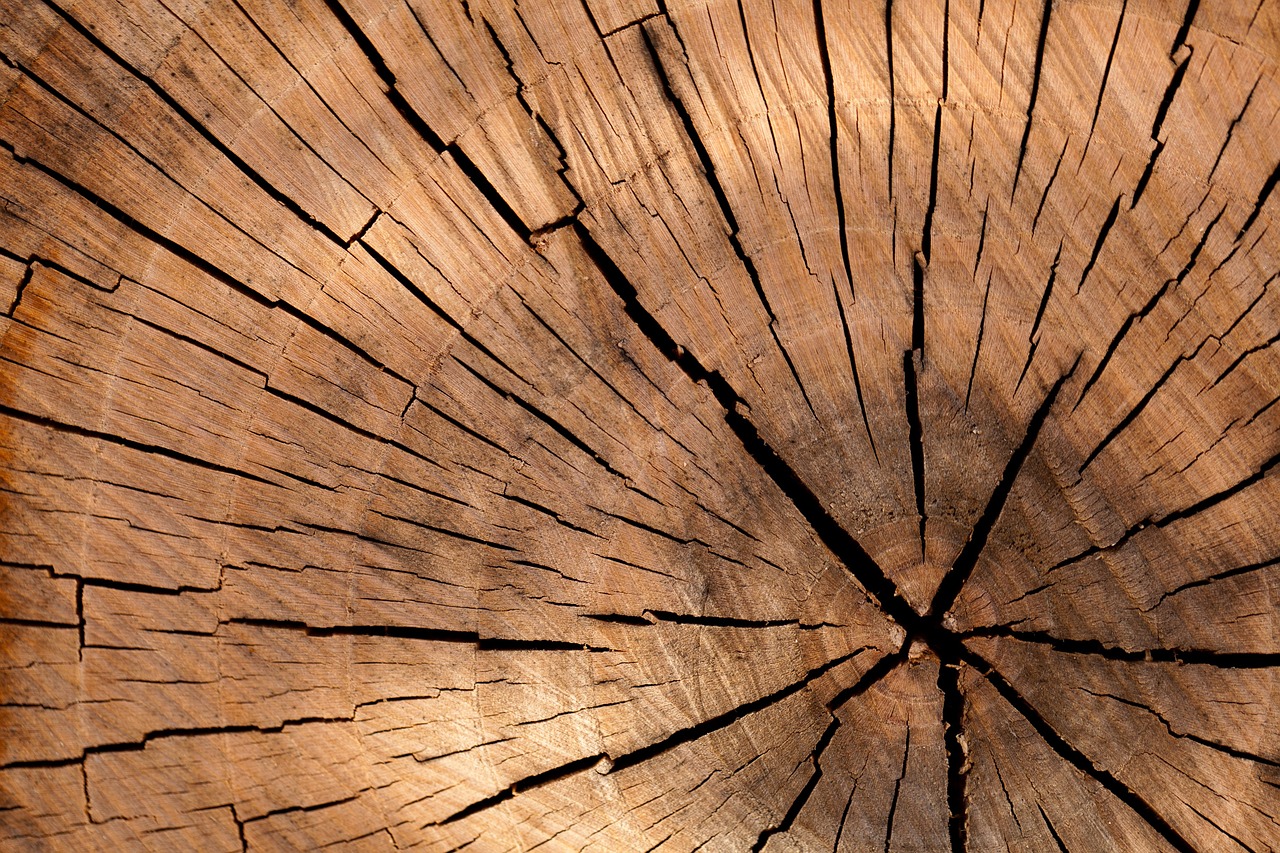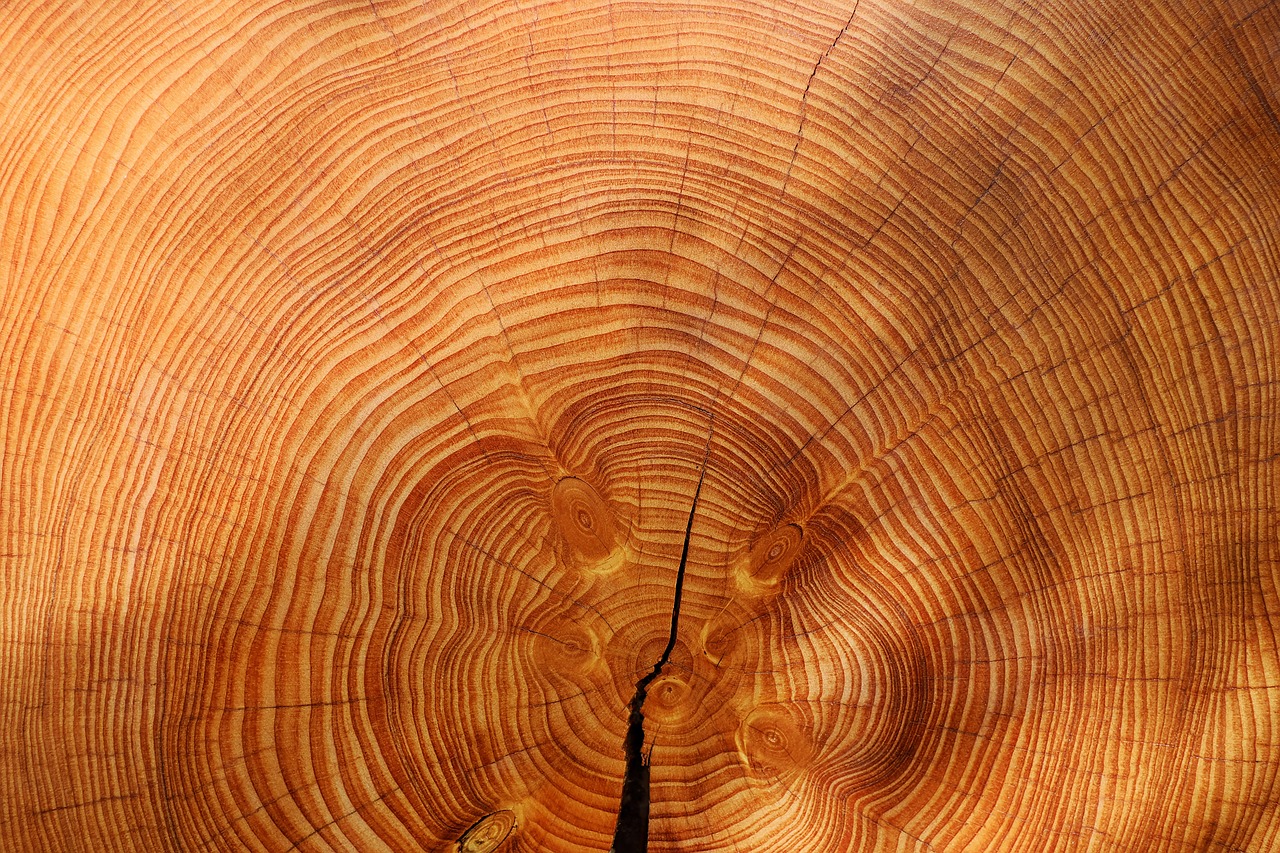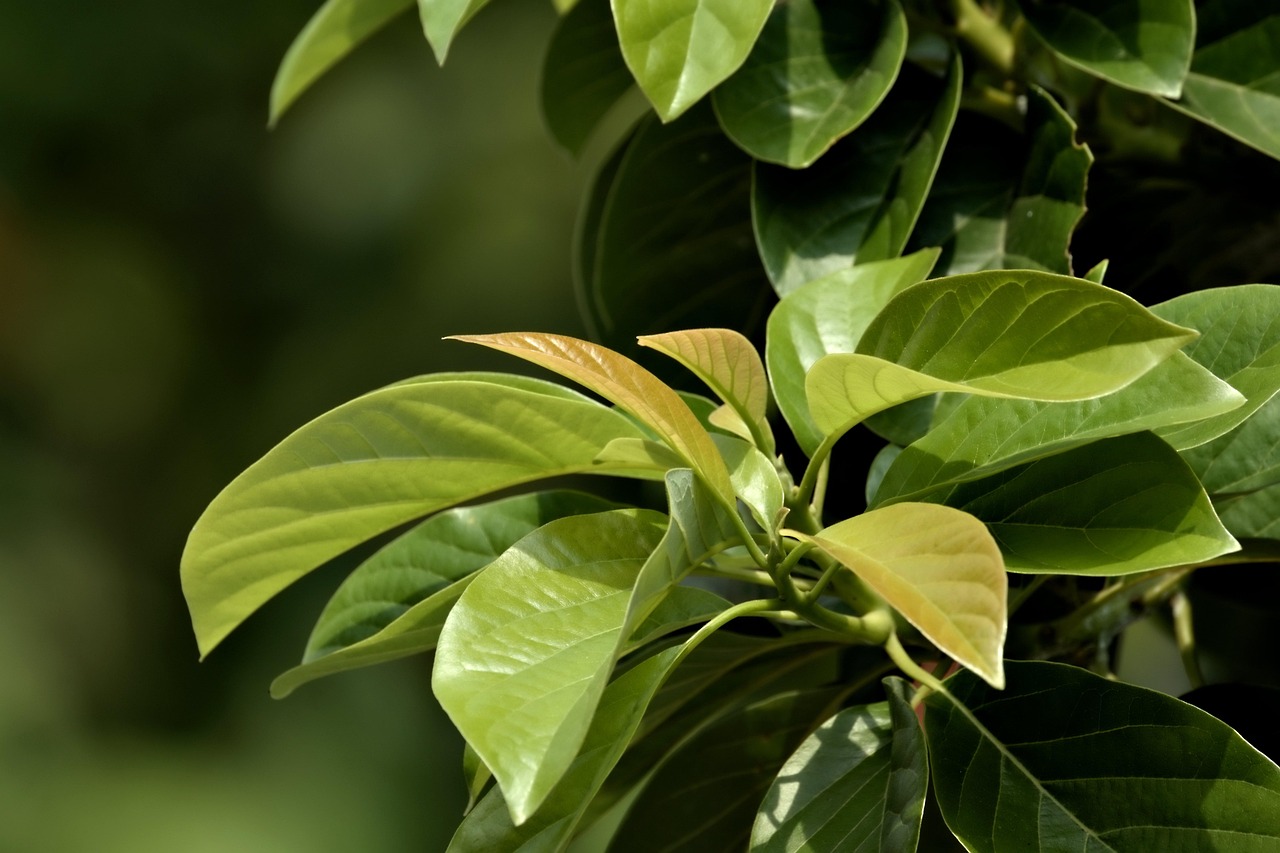Tree growth rings, known as “annuli” in Latin, are formed from layers of xylem produced by a tree each year. These rings reflect the tree’s age and environmental conditions, offering insights into its growth patterns.
Understanding Tree Growth Rings
Tree growth rings are essential for studying the life history of trees. Each ring represents a year of growth, revealing important information about the tree’s age, health, and the environmental conditions it experienced during its lifetime. The study of these rings is known as dendrochronology, which helps researchers understand climate variations and ecological changes over time.

When a tree grows, it produces new layers of wood in its trunk and branches. These layers consist of two main components: earlywood and latewood. Earlywood forms in the spring when growth is rapid. It is typically lighter in color and has a larger cell size. Latewood develops in the summer and fall, characterized by denser, darker cells that form as growth slows down.
The combination of these two types of wood results in the visible rings we observe. In favorable conditions, a tree may produce wider rings, indicating robust growth. Conversely, narrower rings may indicate periods of drought or other stress factors. This variability makes tree rings a valuable resource for understanding historical climate data.
Latin Terms Related to Tree Growth Rings
Understanding the terminology used in the study of tree growth rings can enhance our appreciation of this natural phenomenon. Below are some key Latin terms associated with tree growth and their meanings:

| Latin Term | Meaning |
|---|---|
| Annulus | Ring or circle; refers to the annual growth ring. |
| Xylem | The tissue responsible for water transport within the tree. |
| Phloem | The tissue involved in nutrient transport. |
| Meristem | A region of actively dividing cells that contributes to growth. |
| Cambium | A layer of tissue that produces new xylem and phloem cells. |
These terms provide a foundational understanding of how trees grow and how their growth can be studied through their rings. Each term plays a crucial role in describing the structure and function of trees, especially in relation to their growth processes.
The Importance of Tree Growth Rings
The study of tree growth rings is not only important for understanding individual trees but also for grasping broader ecological concepts. For instance, dendrochronology can reveal patterns in climate change over centuries. By analyzing the width and density of rings in trees from different regions, scientists can reconstruct historical climate data.
This information is vital for various fields, including ecology, archaeology, and even paleoclimatology. It can provide insights into past forest compositions, help track changes in biodiversity, and offer clues about how ecosystems respond to climatic shifts.

Applications of Dendrochronology
Dendrochronology has practical applications that extend beyond academic research. Some of these applications include:
- Dating Historical Events: Trees can be used to date wooden structures or artifacts accurately.
- Climate Reconstruction: Researchers can analyze tree rings to understand past climate conditions.
- Forest Management: Understanding growth patterns helps in managing forests sustainably.
- Ecological Studies: Tree rings provide data on species adaptation to changing environments.
This multifaceted approach illustrates how tree growth rings can be a window into both the past and present environmental conditions. By studying these natural records, researchers can gain insights into how trees have adapted to their surroundings over time, shaping our understanding of ecosystems today.
How Tree Growth Rings Form
Understanding the formation of tree growth rings provides insight into the biological processes that occur within trees. The growth rings develop as a result of the seasonal changes in climate, which influence how trees allocate resources for growth. The primary factors affecting ring formation include temperature, moisture availability, and sunlight.
The Role of Seasonal Changes
In temperate regions, trees experience distinct seasonal changes that influence their growth patterns. During spring, trees begin to grow rapidly as temperatures rise and moisture becomes more available. This period of active growth results in the formation of earlywood. As summer approaches and the conditions become drier, growth slows down, leading to the production of latewood. The contrast between these two phases creates the visible rings.

The width of each ring can vary significantly from year to year, depending on environmental factors. For instance, a wet year may result in a wider ring, while a year of drought may produce a narrower ring. The interplay of these seasonal changes is crucial for understanding tree growth and health.
Factors Influencing Growth Ring Width
Several factors influence the width of growth rings, including:
- Water Availability: Adequate rainfall promotes wider growth rings. Conversely, periods of drought can lead to thinner rings.
- Temperature: Warmer temperatures during the growing season can enhance photosynthesis and growth, resulting in thicker rings.
- Soil Quality: Nutrient-rich soil supports healthy tree growth. Poor soil can limit growth and lead to narrower rings.
- Competition: Trees competing for light and resources may have reduced growth rates, affecting ring width.
Tree Species and Their Growth Rings
Different tree species exhibit unique characteristics in their growth rings. Some species produce distinct rings, while others may have more uniform growth patterns. Understanding these differences is essential for accurately interpreting tree growth data.
Distinctive Growth Patterns in Various Species
Here are some notable examples of tree species and their growth ring characteristics:
| Tree Species | Growth Ring Characteristics |
|---|---|
| Douglas Fir | Wide, distinct rings; often used for dendrochronology due to clear separation. |
| Oak | Prominent rings with varying widths; often used in historical studies. |
| Pine | Narrower rings; can be difficult to distinguish under certain conditions. |
| Redwood | Very wide rings; known for significant growth rates and longevity. |
The differences in ring characteristics among species can affect their interpretation and usefulness in various scientific applications. Some species provide clearer data than others, making them more suitable for specific studies.
The Impact of Environmental Stressors
Environmental stressors can have a profound impact on tree growth and the formation of growth rings. Events such as wildfires, insect infestations, or extreme weather conditions can leave lasting effects on trees, which are often reflected in their rings.
Identifying Stress Through Ring Analysis
When analyzing tree rings, researchers look for signs of stress that may indicate past environmental challenges. These signs include:
- Increased Ring Density: Following a stress event, trees may produce denser wood as a response to adverse conditions.
- Growth Disturbances: Irregularities in ring width can indicate periods of stress or recovery.
- Drought Indicators: Narrow rings in consecutive years suggest prolonged drought periods impacting tree health.
The ability to detect these stress indicators is vital for understanding how trees respond to changing environmental conditions over time.
Case Studies in Tree Ring Research
Numerous case studies illustrate the significance of tree rings in understanding environmental changes. For example, researchers studying ancient bristlecone pines have uncovered data on climate variations over thousands of years. These findings help scientists correlate tree growth patterns with historical climate events, providing valuable insights into ecological shifts.
The ongoing study of tree growth rings continues to unveil critical information about our planet’s past and present environmental conditions. By examining these natural records, we can better understand the impacts of climate change and other ecological challenges that affect forests globally.
Tree Growth Rings and Climate Change
The relationship between tree growth rings and climate change is a significant area of study. Trees serve as natural recorders of environmental conditions, and their growth rings reflect the impacts of climate variations over time. Understanding this relationship is critical for predicting future ecological responses to ongoing climate changes.
How Climate Influences Tree Growth
Climate factors, such as temperature and precipitation, play a crucial role in determining tree growth patterns. Changes in these factors can lead to observable variations in growth ring characteristics. Some of the key influences include:
- Temperature Fluctuations: Warmer temperatures can enhance photosynthesis and growth during the growing season, often leading to thicker rings. However, if temperatures exceed optimal levels, it could result in stress and thinner rings.
- Precipitation Patterns: Increased rainfall typically promotes more robust growth, while drought conditions can stunt growth, leading to narrower rings.
- Extreme Weather Events: Events like hurricanes or severe storms can cause physical damage to trees, impacting ring formation in subsequent years.
Dendroclimatology: A Tool for Climate Study
Dendroclimatology is the scientific discipline that uses tree rings to analyze past climate conditions. By examining ring width, density, and structure, researchers can reconstruct historical climate data. This method provides valuable insights into how climate has changed over centuries and how these changes have affected ecosystems.
Key aspects of dendroclimatology include:
- Data Collection: Core samples are taken from trees without damaging them. These samples are analyzed for growth ring characteristics.
- Statistical Analysis: Researchers use statistical methods to correlate ring patterns with known climate data, helping to establish relationships between growth rates and environmental conditions.
- Regional Studies: Dendroclimatology can be applied across different regions to understand local climate variations and their effects on tree growth.
Understanding Tree Ring Patterns
Tree ring patterns provide a wealth of information about a tree’s life history and the environmental conditions it has faced. Recognizing these patterns can help researchers draw conclusions about ecological changes in various regions.
Growth Ring Anomalies
Sometimes, trees exhibit anomalies in their growth rings that indicate unusual environmental conditions. These anomalies can include:
- False Rings: These occur when a tree experiences a disturbance that causes it to stop growing temporarily and then resume. The result is an additional, sometimes misleading, ring.
- Compression Wood: Found on the lower side of leaning trees, this wood is denser and may appear as an abnormal growth pattern in rings.
- Drought Rings: Narrow rings that indicate periods of water scarcity. They can be used to identify historical drought events.
Interpreting Growth Ring Data
The interpretation of growth ring data requires careful analysis and understanding of various factors that influence tree growth. Key considerations include:
- Species Differences: Different species respond uniquely to environmental changes, affecting the interpretation of their growth rings.
- Site Conditions: Soil quality, exposure to sunlight, and competition from other plants can all affect growth patterns.
- Temporal Context: Understanding the period in which the growth occurred is essential for accurate interpretations; what may seem like a drought year in one period could reflect normal variability in another.
The Future of Tree Ring Research
The study of tree growth rings continues to evolve with advancements in technology and methodologies. Researchers are now employing modern techniques such as:
- Remote Sensing: Satellite imagery is being used to assess forest health and monitor changes in tree growth over large areas.
- Molecular Techniques: Genetic analysis provides insights into how trees adapt to climate change at a molecular level.
- Modeling Software: Advanced simulations help predict future tree growth patterns based on current climate models.
This integration of new technologies enhances our understanding of how trees interact with their environment and how we can manage forests sustainably in the face of ongoing climate change.
The Interdisciplinary Impact of Tree Ring Research
The study of tree growth rings has implications that reach beyond forestry and climate science. It intersects with various disciplines, enriching our understanding of environmental science, archaeology, and even art. By examining tree rings, researchers can glean insights applicable to many fields.
Applications in Archaeology
In archaeology, dendrochronology plays a vital role in dating wooden artifacts and structures. By matching the growth rings of ancient wood samples with those from living trees, archaeologists can establish timelines for historical events. This technique has been crucial in understanding past civilizations and their interactions with their environments.
- Dating Structures: Wooden buildings and shipwrecks can be dated accurately, providing insight into construction techniques and historical timelines.
- Understanding Past Climates: Dendrochronology can reveal how ancient societies adapted to climate changes, helping us understand human resilience.
Art and Aesthetics
Interestingly, tree rings also have applications in the arts. The unique patterns of growth rings are often used in woodworking and furniture design, appreciated for their beauty and uniqueness. Artists and craftsmen can use the characteristics of wood grain to create visually stunning pieces that tell the story of the tree’s life.
The aesthetic appeal of tree rings has led to a movement toward using sustainably sourced wood in art and design. By valuing the history captured in each ring, artists promote a deeper appreciation for natural materials.
Challenges Facing Tree Growth Research
Despite the advancements in tree ring research, several challenges remain. Factors such as climate variability, deforestation, and pollution can complicate the interpretation of growth rings.
Climate Variability
The increasing unpredictability of climate patterns poses challenges for researchers. Variability in temperature and precipitation influences tree growth in ways that can obscure long-term trends. As trees adapt to these changes, understanding their responses becomes even more complex.
Deforestation and Habitat Loss
Deforestation not only reduces the number of trees available for study but also disrupts ecosystems that rely on these trees for stability. The loss of forests affects biodiversity and alters local climates, further complicating the relationship between trees and their environment.
Pollution Effects
Air and soil pollution can significantly impact tree health. Contaminants can affect growth rates and the overall vitality of trees, leading to misleading interpretations of ring data. Researchers must account for these variables when analyzing growth patterns.
Final Thoughts
Tree growth rings are more than just annual markers of time; they are a comprehensive record of environmental history. From providing insights into climate change to aiding archaeological studies, the significance of tree rings extends across multiple disciplines. Understanding these natural records allows us to appreciate the complex relationship between trees and their environment.
As research methods advance, the insights gained from tree growth rings will continue to evolve. By embracing interdisciplinary approaches, we can deepen our understanding of ecological changes and enhance our efforts toward sustainable forest management. The lessons learned from trees will be invaluable as we navigate the challenges posed by climate change and environmental degradation in the future.
In conclusion, the exploration of tree growth rings not only enriches our knowledge of past climates but also informs our present and future strategies for conservation and sustainability. As we continue to study these remarkable natural records, we gain essential tools for addressing the pressing ecological issues of our time.
